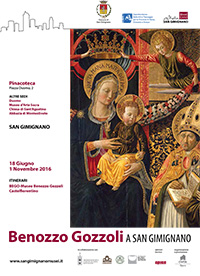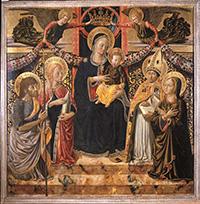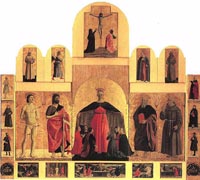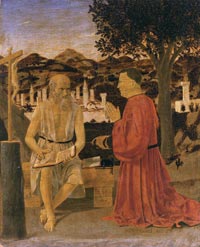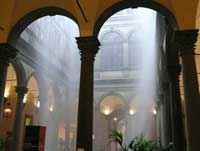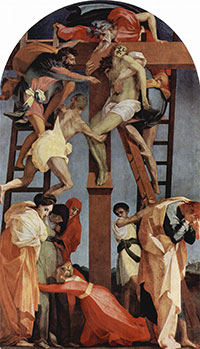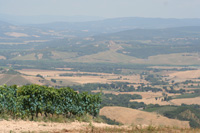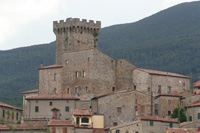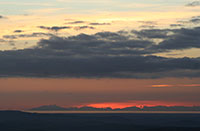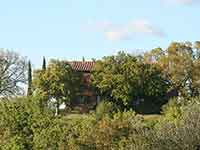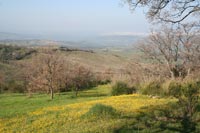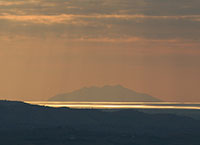 |
| Nativity of Christ between San Giorgio and San Vincezo Ferrer, Filippo Lippi, Palazzo Pretorio Museum, Prato |
Art and Exhibitions | Calendar of major events in Tuscany and Italy
|
Firenze, Tethis Gallery |
|||||
| Balthazar Korab – I giorni dell’Alluvione | The days of the flood |
|||||
|
|||||
Balthazar Korab was one of the most famous and prolific architectural photographers of the last century, Balthazar Korab. His images of the works of Mies Van Der Rohe and Frank Lloyd Wright, of Le Corbusier, Richard Meier and above all Eero Saarinen, were published worldwide in books and magazines from the late 1950s onwards, earning him awards, prizes and exhibitions in the years to come. At the height of his success, in the autumn of 1966, he decided to take a sabbatical year and, with his wife and two children, came to Italy. He arrived in Florence, more precisely in Settignano, in the first days of November of that year and, purely by chance, he found himself witnessing the flood that devastated the city shortly afterwards, recounting it in a series of shots that are now, on the occasion of the fiftieth anniversary of that event, on show at the Tethys Gallery in the exhibition Balthazar Korab. I giorni dell'Alluvione, curated by John Comazzi, Christian Korab, Guido Cozzi and Massimo Borchi, from 27 October to 26 November 2016. The exhibition is organised in collaboration with the University of Minnesota. |
|
||||
| Balthazar Korab, Piazza del Duomo dopo l'alluvione di Firenze del 4 novembre 1966, col il manichino di un negozio di abbigliamento che l’acqua ha avvinghiato a un palo Balthazar Korab was one of the most sought-after professional architectural photographers in the United States during the 1960s. Korab often said that his life and career had been shaped more by coincidence than by any premeditated plan. In the fall of 1966, Korab had decided to take a sabbatical in Italy with his wife and children and so he happened to be in Florence during the events of November 4, 1966. After two weeks of heavy rain, the Arno River had risen to its highest levels since 1333, creating one of the most damaging natural disasters in Florence's history. The Korabs had just settled into a small apartment in the hills of Settignano when they awoke early in the morning to the end of the floods that had submerged the center of Florence. With his medium format Hasselblad camera and five rolls of film, Korab made his way to Florence to document the dramatic events. He waded through the freezing waters—at times chest-deep—to capture some of the most extraordinary images of the flood and its immediate aftermath. The next morning, he traveled to Rome to have his film developed. In the days and weeks following the flood, Korab continued to document the damage to the city’s buildings, monuments, and artworks, and the enormous efforts by professionals and volunteers who helped restore precious works of art from the Uffizi Gallery, the Institute and Museum of the History of Science, and the National Library. Text by John Comazzi
|
Balthazar Korab, Piazza del Duomo after the Florence flood of 4 November 1966, with a clothing shop mannequin that the water has clung to a pole |
||||
Perugia, Galleria Nazionale |
|||||
| Francesco e la Croce dipinta |
|||||
|
|||||
| Attraverso una serie di capolavori tutti provenienti dal territorio umbro, realizzati tra la fine del 1200 e la prima metà del 1300, l’esposizione segue lo sviluppo della croce dipinta, in cui il motivo iconografico si legò sempre più frequentemente alla figura di san Francesco d’Assisi. Dal 30 ottobre 2016 al 29 gennaio 2017, la Sala Podiani della Galleria Nazionale dell’Umbria di Perugia ospita una preziosa esposizione che documenta lo sviluppo della croce dipinta, a partire dagli anni settanta del Duecento fino al primo ventennio del secolo successivo, in cui il motivo iconografico si legò sempre più frequentemente alla figura di san Francesco d’Assisi, spesso rappresentato ai piedi della croce, in adorazione del Cristo. Le croci dipinte che sono state scelte per la mostra presentano nel suppedaneo frate Francesco, collocato dove sovente si trova la classica immagine del teschio posto ai piedi del Cristo giudice o dello stesso Christus patiens, come ad esempio nella croce di Giotto a Padova.
|
|
||||
Museo degli Innocenti |
|||||
| Benozzo Gozzoli in San Gimignano |
|||||
|
|
||||
The Pinacoteca of San Gimignano is hosting an exhibition on Florentine Benozzo Gozzoli, a Renaissance master and one of the most prolific painters of the Italian Quattrocento.
|
|||||
Hans Op de Beeck, “Small Things and Soothing Thoughts” Galeria Continua, San Gimignano
|
|||||
Galleria Continua presents “Small Things and Soothing Thoughts”, a solo show by Hans Op de Beeck, a prominent figure on the international art scene. "The Collector's House" is already marked as one of the most memorable installations of this year's Art Basel Unlimited.
|
|||||
Che il vero possa confutare il falso
|
|||||
Opening 25 jun 2016 at 18:30 Palazzo Pubblico - Santa Maria della Scala - Accademia dei Fisiocritici Artists included
|
|||||
| David Adamo, Georges Adeagbo, Gundam Air, Kader Attia, Massimo Bartolini, Francesco Carone, Isabelle Cornarò, Berlinde De Bruyckere, Mark Dion, Helene Dowling, Haris Epaminonda, Cyprien Gaillard, Luigi Ghirri, Rodrigo Hernández, Judit Hopf, Paolo Inverni, Johnson Rashid, Esther Kläs, Christiane Löhr, Ursula Mayer, Jhonatan Monk, Giovanni Morbin, Ivan Moudov, Marzena Nowak, Adrian Paci, Giulio Paolini, Oliver Payne and Nick Relph, Susan Philpsz, Steve Roden, Vanessa Safavi, Michael Sailstorfer and Jürgen Heinert, Anri Sala, Tino Sehgal, Johnatan Seliger, Alexandre Singh, Andreas Slominski, Padraig Timoney, Mario Garcia Torres, Luca Trevisani, Nobuko Tsuchiya, Richard Tuttle, Franco Vaccari, Eugenia Vanni, Nico Vascellari, Nari Ward, Davide Mancini Zanchi, Christian Manuel Zanon |  |
||||
A partire da sabato 25 giugno alcuni tra i più bei palazzi storici di Siena aprono al pubblico per accogliere Che il vero possa confutare il falso, una mostra sulla collezione di opere d’arte contemporanea di AGIVERONA Collection, a cura di Luigi Fassi e Alberto Salvadori. AGI Verona | Contemporary Art | Anna e Giorgio Fasol | www.agiverona.org
|
Veduta Sagrestia Vecchia, Santa Maria della Scala, Siena con la Madonna del manto di Domenico di Bartolo, 1444, affresco staccato, e Animal di Berlinde De Bruyckere. Courtesy AGIVERONA Collection, GALLERIA CONTINUA
|
||||
| Reopening of the Museo degli Innocenti, Florence | |||||
23rd June 2016 – Reopening of the Museo degli Innocenti, Florence
|
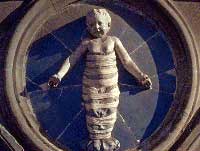 |
||||
Ambrogio Lorenzetti. Inside the restoration
|
|||||
The frescoes of the Hermitage of Montesiepi, near the Abbey of San Galgano, together with the polyptych from the Chiesa di San Pietro in Castelvecchio, are being restored and are temporarily on view in Siena.
|
|||||
Piero della Francesca. Indagine su un mito | Piero della Francesca. Exploring a legend Musei San Domenico., Forlì
|
|||||
 |
|||||
Piero della Francesca, Madonna della Misericordia, 1445-1462, olio su tavola. Museo Civico, Sansepolcro
|
|||||
La mostra “Piero della Francesca. Indagine su un mito”, che celebra il mito di questo genio del rinascimento italiano, è allestita ai Musei San Domenico di Forlì, dal 13 febbraio al 26 giugno 2016 e conta più di 250 opere. La mostra, che rende concettualmente omaggio al saggio di Roberto Longhi dedicato a Piero, consente di ammirare la grandezza e la modernità di Piero della Francesca. Alcuni dipinti di Piero, scelti per tracciare i termini della sua riscoperta, costituiscono il cuore dell'esposizione. Accanto ad essi figurano in mostra opere dei più grandi artisti del Rinascimento che consentono di definirne la formazione e poi il ruolo sulla pittura successiva. Per illustrare la cultura pittorica fiorentina negli anni trenta e quaranta del Quattrocento, che vedono il pittore di Sansepolcro muovere i primi passi in campo artistico, saranno presenti opere di grande prestigio di Domenico Veneziano, Beato Angelico, Paolo Uccello e Andrea del Castagno, esponenti di punta della pittura post-masaccesca. L'accuratezza prospettica di Paolo Uccello e l'enfasi plastica delle figure di Andrea del Castagno, la naturalezza della luce di Domenico Veneziano, l'incanto cromatico perseguito da Masolino e dall'Angelico, costituiscono una salda base di partenza per il giovane Piero. Ma la mostra vuol dar conto anche dei primi riflessi della pittura fiamminga, da cogliere negli affreschi del portoghese Giovanni di Consalvo, nei quali l'esattezza della costruzione prospettica convive con un'inedita attenzione per le luci e le ombre. The complex interaction of art and criticism, creative output and scholarship, is the aim of Piero della Francesca. From the success during his life – Luca Pacioli defined him “the king of painting” till being forgotten and newly
|
|
||||
| Piero della Francesca | Exploring the Resurrection
March 19th . July 17th 2016
|
|||||
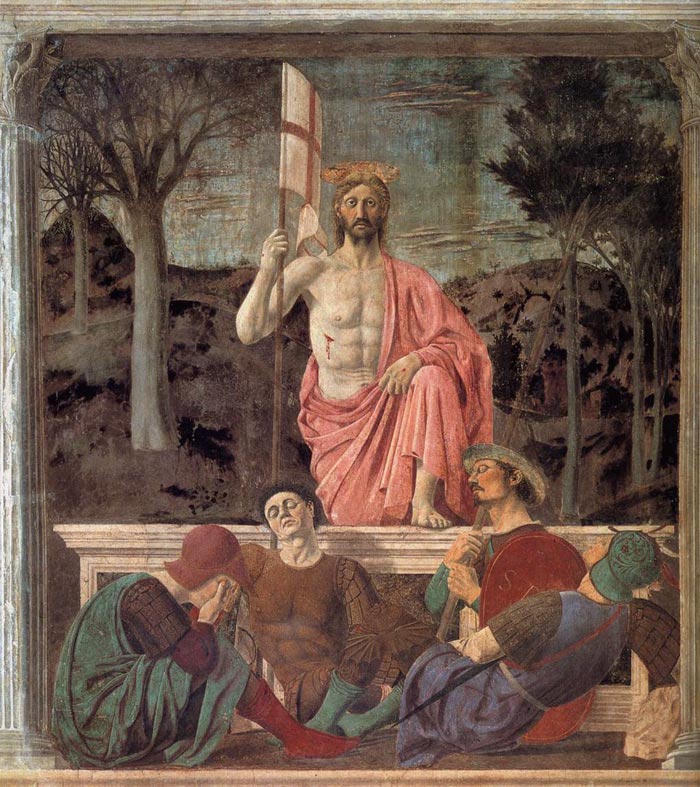 |
|||||
Piero della Francesca, The Resurrection, Museo Civico of Sansepolcro
|
|||||
Thanks to a collaboration agreement with the Opificio delle Pietre Dure in Florence and the Fine Arts and the Pesaggio of Siena, Grosseto and Arezzo Superintendence, the City of Sansepolcro is restauring the Resurrection, famous fresco by Piero della Francesca, preserved in the Palazzo dei Conservatori, inside the Civic Museum. To enhance the work of Piero and surveys carried out on during the restoration, in the same hall that houses the Resurrection, there will be an exhibition entitled Exploring the Resurrection.
|
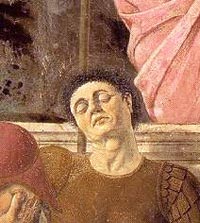 Piero della Francesca, The Resurrection (self-portrait, detail of fresco), Museo Civico of Sansepolcro Piero della Francesca, The Resurrection (self-portrait, detail of fresco), Museo Civico of Sansepolcro |
||||
| From Kandinsky to Pollock. The Art of the Guggenheim Collections Palazzo Strozzi - March 19 - July 24, 2016 |
|||||
| A major exhibition bringing to Florence more than 100 major works of European and American art from the 1920s to the 1960s in a narrative that reconstructs the relationship and the ties between the two sides of the Atlantic through the lives of two leading American collectors, Peggy and Solomon Guggenheim. The exhibition is a collaboration between the Fondazione Palazzo Strozzi and the Solomon R. Guggenheim Foundation of New York. The exhibit will be offering visitors a unique opportunity to explore the work of European masters of modern art such as Marcel Duchamp, Max Ernst, Man Ray and Pablo Picasso and European masters of so-called Art Informel, such as Alberto Burri, Emilio Vedova, Jean Dubuffet, Lucio Fontana, with large paintings and sculptures by some of the most important personalities on the American art scene in the 1950s and 1960s such as Jackson Pollock, Mark Rothko, Willem de Kooning, Alexander Calder, Roy Lichtenstein and Cy Twombly.
Upcoming exibition: Ai Weiwei at Palazzo Strozzi
|
|
||||
 |
|||||
Vasily Kandinsky, Dominant Curve, April 1936. Oil on canvas, Solomon R. Guggenheim Museum, New York |
|||||
| The Violated Canvas | La tela violata Fontana, Castellani, Bonalumi, Burri, Scheggi, Simeti, Amadio and researching the physical use of the third dimension March 19 to June 19, 2016 |
|||||
| About fifty canvasses by eight artists that, starting in the 1950s, revolutionized the art scene, transgressing the pictorial surface. Explore the artwork of Fontana, Castellani, Bonalumi, Burri, Scheggi, Simeti and Amadio. The exhibition takes into consideration the art movement of Spatialism with particular attention to Azimuth, the magazine founded by Piero Manzoni and Enrico Castellani that engaged intellectuals, art critics and artists in the debate on what art represented, and Azimut, an exhibition space also founded by Manzoni and Castellani, in collaboration with Agostino Bonalumi.
|
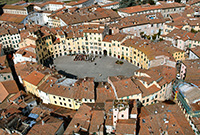 Lucca |
||||
The shadow of the Etruscans | Symbols of a people between the plains and hills A journey throughtime exploring the sacred and the underworld horizons to rebuild the threads of the Etruscan civilization that in ancient times spread on the north area of the Arno river, along the direction of the Florence-Prato-Pistoia plain, the Mugello/Val di Sieve and Montalbano wide territory. |
|||||
Between stones, bronzes and steles, distant cultural roots in Tuscany is recontructed through Prato with an epicenter of Gonfienti, to whome the first section is fully dedicated. Particular attention is given to the sacred objects including bronze statues and objects in glass. The second section is focused on the production of "Fiesole stones" that characterize this vast territory from which emerged, during the Etruscan age, the centers of Artimino, Fiesole and Gonfienti: steles and stones and decorated relief monuments that identify noble families coming from funerary contexts of the targeted area.
|
|||||
ITINERA Siena Brussels. Launch of a European project for artists and curators
|
|||||
A residency program based on the idea of exchange between two European cities: Siena and Brussels. Between 2015 and 2017 artists to curators will travel and will design exhibitions, activities, meetings. ITINERA Siena Bruxelles. Al via un progetto europeo per artisti e curatori Un programma di residenze fondato sull'idea di scambio tra due città europee: Siena e Bruxelles. Tra il 2015 e il 2017 artisti a curatori viaggeranno e progetteranno mostre, attività, incontri.
|
|||||
ITINERA #1 from Lorenzo Pallini on Vimeo
|
|||||
This is an extract from the press conference held in 22 October 2015 Links | www.artribune.com
|
|||||
| Robert Capa in Italy Until August 15, 2016 |
|||||
A black and white photography exhibition by Robert Capa covering the years 1943-44 telling the story of the arrival of the Allies in Italy. This show features images by the great war photojournalist, who was among the founders of the Magnum agency and was present for the allied invasion of Sicily in July 1943. Considered the father of photo-journalism, Robert Capa, lived a large part of his life on the battlefield - even though he was not a solider, documenting the life in war with photos that capture the settings, the pain and documenting the facts.
|
|||||
| Master of Kitsch Jan Fabre in Florence |
|||||
Works by multidisciplinary Belgian Master of Kitsch Jan Fabre are now in Florence for Spiritual Guards, an exhibition taking place in piazza della Signoria, Palazzo Vecchio and Forte di Belvedere until 2 October 2016. The sculptures serve an ornamental and decorative purpose rather than amounting to a work of true artistic merit. To avoid.
|
|||||
| ROSSO FIORENTINO. ROSSO VIVO. La Deposizione, la Storia, il ‘900, il Contemporaneo A cura di Vittorio Sgarbi 23 maggio 2014 > 31 dicembre 2015 |
|||||
Scultori e pittori saranno esposti presso gli spazi di Palazzo dei Priori, Pinacoteca Civica, Museo Etrusco Guarnacci, Battistero di San Giovanni, Teatro Romano, Ecomuseo dell'Alabastro e si alterneranno nel corso dell’esposizioni: questo darà vita a un continuo rinnovamento dell’iniziativa, che vedrà eventi dedicati continui. Fino al 31 dicembre 2015 questo grande omaggio a Rosso Fiorentino, la più originale e spettacolare manifestazione mai dedicata al grande maestro nato a Firenze nel 1495, sarà visibile con un solo biglietto valido per tutti i luoghi, la Volterra Card, che permetterà a ogni visitatore di godere della sorprendente esposizione diffusa per la Città. ORARIO ESTIVO dal 9 marzo al 1 novembre 2015 Pinacoteca Civica: Tutti i giorni 9.00 – 19.00 Ecomuseo dell’Alabastro: Tutti i giorni 9.30 – 19.00 Battistero di san Giovanni: Tutti i giorni 10.00 – 18.00 Palazzo dei Priori: Tutti i giorni 10.30 – 17.30 Museo Etrusco Guarnacci: Tutti i giorni 9.00 – 19.00 Teatro Romano: Tutti i giorni 10.30 – 17.30 (la biglietteria chiude un’ora prima)
|
|
||||
|
|
|||||
|
||||
|
||||
Tuscany is widely regarded as the true birthplace of the Italian Renaissance and is known for its beautiful landscapes, its rich artistic legacy and vast influence on high culture. Podere Sante Pia, a holiday estate in beautiful southern Tuscany Italy, is the perfect place for the perfect holiday.
|
||||
View from Podere Santa Pia
on the coast and Corsica |
||||
Podere Santa Pia |
Podere Santa Pia, garden |
The Maremma and isola Monte Christo, view from Santa Pia
|
||
La Toscana è una regione ricca di risorse da questo punto di vista, il suo paesaggio è unico al mondo e la zona della Maremma presenta vaste e verdi distese di natura incontaminata dove sorgono strutture turistiche davvero esclusive, confortevoli e alla portata di tutti. Una di queste è Podere Santa Pia, un’oasi di silenzio e quiete, una struttura formata da tre diversi resort immersi nel verde e nei profumi della Maremma toscana.
|
||||
 |
||||
Podere Santa Pia, con una vista indimenticabile sulla Maremma Toscana. La terrazza è esposta a Sud per cui dalla mattina al pomeriggio è sempre colpita dal sole, tuttavia ci sono zone ombreggiate grazie agli alberi circostanti. |
||||

